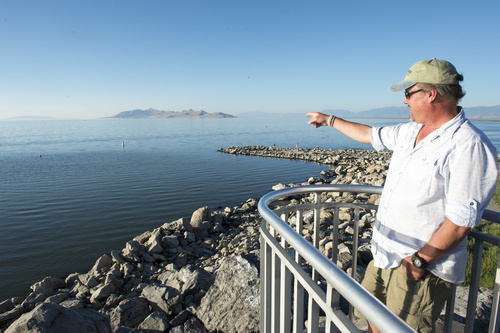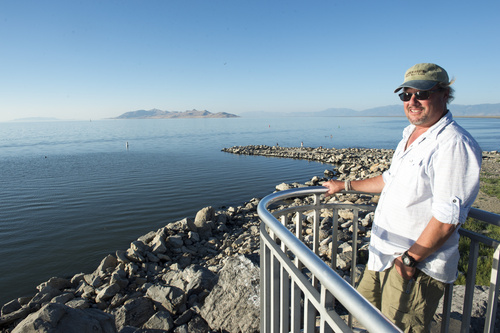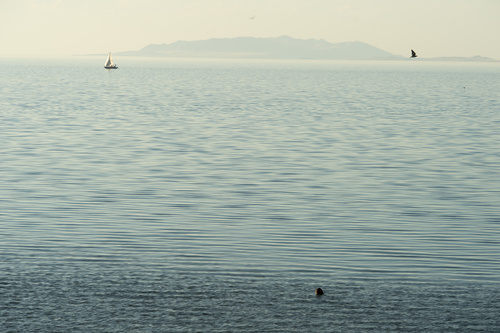This is an archived article that was published on sltrib.com in 2014, and information in the article may be outdated. It is provided only for personal research purposes and may not be reprinted.
Great Salt Lake • Low water is not always a bad thing for boaters. At least boaters with a taste for the history of the lakes they sail.
"Current levels mean the Great Salt Lake is giving up a lot of its secrets," said Dave Shearer, harbor master of the Great Salt Lake State Marina.
Among them is the possible wreckage of a vessel Mormon prophet Brigham Young ordered built to shuttle cattle to and from Antelope Island starting in 1854.
Water levels are currently 6 feet under the average for this time of year and 18 feet below the highest mark, prompting Shearer to embark on scouting missions in search of wrecks for long lost boats on the Great Salt Lake.
"This is as low as it has been since 1963. Even though we had good snowpack in the Wasatch and Uinta mountains this past winter, the previous two winters were so dry that all the water this winter went into the reservoirs and the ground and never made it to the Great Salt Lake," Shearer said. "Six feet below normal is huge. The Great Salt Lake is massive. Try and imagine how much 6 feet of water is for a lake this big."
Sailboats with deep keels are trapped in the Great Salt Lake Marina and some have been hoisted by crane out of the water until the levels increase. The Antelope Island Marina is also too low for large crafts, and Shearer said the marina used by brine shrimpers had to be dredged to make it usable.
But while conditions are tough for boating, they're ideal for discovering historic boats.
As it turns out, one of the lost ships Shearer was looking for was right under his nose.
The remains of the W.E. Marsh No. 4, part of the Southern Pacific Railroad fleet used to help construct and then maintain the Lucin Cutoff trestle across the northern end of the lake and last reported seen afloat in 1936, was discovered this spring near the marina.
The keel of a sailboat had fallen off in the main channel, and with the low water Utah State Parks officials were concerned it could prove a hazard for other sailboats. The crew was using side-scan sonar to search for the keel when they found something they thought fit the description.
"The diver went to check it out and came up with a chunk of wood," said Shearer, who lives and works at the marina.
Using measurements and historical records of the W.E. Marsh No. 4, Shearer is convinced it is the missing boat which launched on Great Salt Lake sometime before 1910.
In July the lake water cleared and people could easily see the sunken boat from the observation deck at the marina. Shearer said the water will clear again sometime in the next two weeks and should provide another viewing opportunity. It is currently marked with a buoy.
He plans to collect more photos — historic and underwater ones of the current wreck — and create an information area in the new visitors center at the Great Salt Lake Marina.
Information about boats known to use the lake, including ones used by Kit Carson and John C. Fremont, Brigham Young and the Southern Pacific Railroad fleet, among others, will also be included.
Shearer is fairly confident the dinosaur rib cage-like remains of another vessel he found are the Timely Gull, but state historians say more work needs to be done to confirm the wreck was that of the cattle ferry, and sometimes pleasure boat, ordered by Young, the Mormon leader.
"We went out to look at and record the wreck," said Lori Hunsaker, deputy state historic preservation officer with the Utah Division of State History. "It is consistent with the reports of the Timely Gull, but there are still some questions, and we wouldn't really know for sure unless an excavation is done."
Salt water and the mud of the Great Salt Lake are doing a decent job of preserving the remains of the ship.
Any effort to excavate the wreck would be costly and labor intensive, and Hunsaker is not sure when, or if, it might happen.
The Timely Gull, which was reportedly designed to be powered by horses on a treadmill, was later outfitted as a sailboat.
The boat did not have a long floating life.
In 1858 the Timely Gull broke free of her moorings near Black Rock and a storm sent the vessel toward the south tip of Antelope Island, where it eventually sank.
"While the low water is unfortunate, it is exciting from a historical standpoint," Hunsaker said. "The information from the wrecks tells us about the past habitation and use of the lake. Besides that, it is fun."
Twitter: @BrettPrettyman









